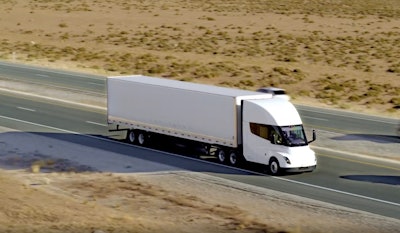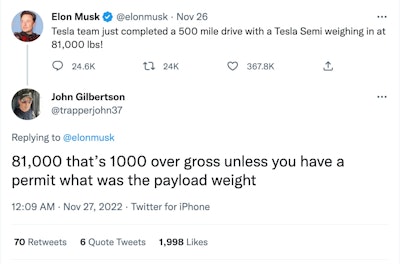
This past Sunday night following countless Thanksgiving feasts, memorable football and soccer games and Black Friday shopping, Tesla CEO Elon Musk made a little history of his own by tweeting that his company’s soon-to-be-delivered electric Semi had made a 500-mile trip while “weighing in at 81,000 lbs.!”
Musk’s announcement comes just days before the scheduled Dec. 1 delivery of 15 Semis to Pepsi. How many pounds of soda will the trucks be capable of hauling compared to internal combustion? Good question.
It’s really the same question that trucker John Gilbertson posed in what has now become a top response to Musk’s Semi tweet on Sunday. Gilbertson first asked if Semi was permitted to exceed the 80,000 lb. weight limit and then asked how much of Semi’s 81,000 lb. weight was comprised of actual payload.
As of Wednesday morning, Gilbertson’s Tweet had nearly 2,000 likes, 70 retweets and six quote tweets. What it didn’t have was an answer for payload. As such, Gilbertson’s question recalls that famous line from a 1980s Wendy’s commercial, “Where’s the beef?”
 Twitter
Twitter
The bigger question on Semi’s payload capacity during this 500-mile trip, however, is still unknown. Musk also makes no mention of how long that 500-mile trip took, nor what kind of ambient temperatures or topography Semi was up against which can impact range.
Two versions of Semi are currently offered: the 500-mile model at $180,000 and a 300-mile version at $150,000. According to Tesla’s website, those ranges are based on Semi being “fully loaded at 82k lbs. gross combination weight.”
While Semi’s payload capacity is not listed, we may be able to get a rough idea based on the curb weight of an electric Kenworth T680E (thanks to Kenworth for passing this along). The T680E comes in at 22,500 lbs.; the diesel-powered T680 weighs 15,500 lbs. or 7,000 lbs. less (37% less) than its battery-powered counterpart.
It’s no secret that an EV generally weighs more than a comparable internal combustion vehicle. Because of extra battery weight, the Rivian R1T pickup and Ford Lightning F-150 are actually Class 2 vehicles whereas their internal combustion equivalents are Class 1. A Class 2 designation means spending more in annual registration fees at the DMV. (Read more about that here.)
[Related: DMV registration fees much higher for electric trucks]
What’s interesting in the case of Semi is that it offers up to a 500-mile range while Kenworth’s T680E is capable of delivering up to 150 miles. That’s a huge difference and getting there obviously means relying on additional battery power which means additional vehicle weight. That is of course unless Semi is using revolutionary batteries (something like solid-state which reportedly has twice the energy density and half the weight of conventional lithium ion). Also, improved aerodynamics and vehicle light-weighting (using carbon fiber in place of steel, for instance) can increase range while maintaining overall vehicle integrity.
Though there aren’t many specs listed for Semi, those that Tesla has made available on its website look impressive: fuel savings up to $200,000 in three years over diesel; 70% of range restored with 30 minutes of fast-charging; and maintains a highway speed limit up a 5% grade.
Payload? There’s nothing listed yet which begs that old question, “Where’s the beef?”









